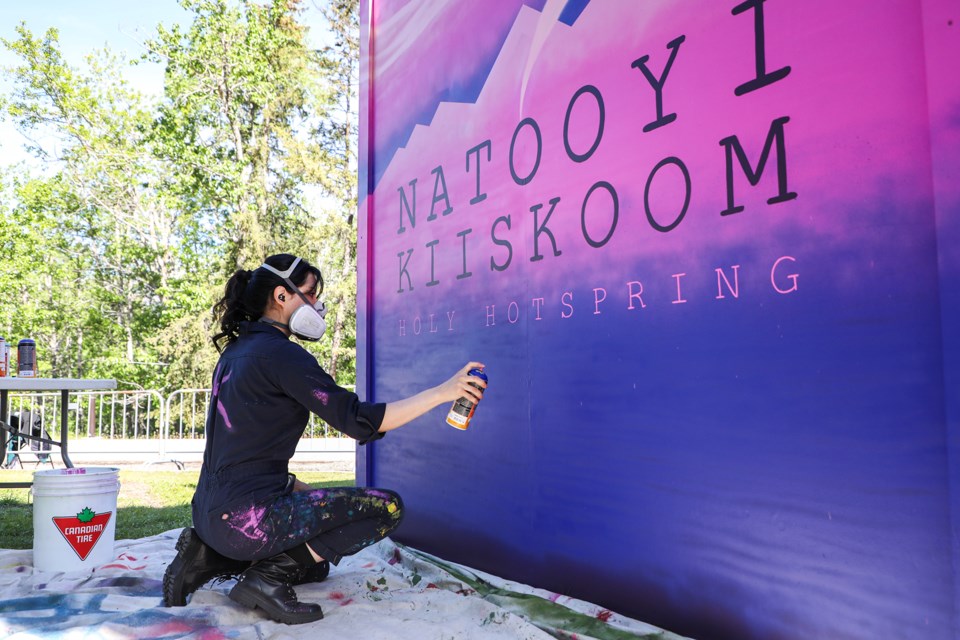BANFF – Brothers Kyle (Eagle Child) Kaquitts and Jarron (Black Bear) Poucette spent countless hours captivated by their grandfather, Frank (Sitting Wind) Kaquitts, as he wove life onto canvas with the dancing strokes of his paintbrush.
Observing and absorbing their grandfather’s teachings set them loose on their own creative journeys, wielding paintbrushes and experimenting with other artistic mediums.
“As kids, every day, we used to go downstairs and paint for hours and hours, and we would spend time with our grandfather’s paintings. He was a true artist and he inspired us,” said Kaquitts. “We want to carry on his legacy.”
The brothers are part of a collective of six Indigenous artists selected to create four-walled murals at the Cave and Basin National Historic Site in Banff National Park – each piece depicting aspects of cultural heritage and connection between Indigenous peoples and the natural environment of the Rocky Mountains.
The mural and mentorship project is a partnership between the Whyte Museum of the Canadian Rockies and Parks Canada.
Kaquitts and Poucette, both of Goodstoney First Nation, were determined to honour the relationship of the Îyârhe (Stoney) Nakoda with the museum’s founders, Peter and Catharine Whyte, in their work.
Both were honorary members of the First Nation and Sitting Wind – a renowned artist, actor and Îyârhe Nakoda chief – often visited the couple. He was a young man when Peter started mentoring him.
“I think it was Peter that got him into art school, paying for his tuition and everything,” said Kaquitts.
Catharine, too, was a strong supporter of the First Nation and was given the name Princess White Shield in 1970. She was gifted with regalia made by the Îyârhe Nakoda, intricately beaded with colours of red, pink, white and blue.
The colours enrobe Eyarhey Tatanga Woweyahgey Wakân, or Sleeping Buffalo Mountain, as it is known to the Îyârhe Nakoda, on two of four walls of Kaquitts’ and Poucette’s mural.
“It’s really special that this piece tries to honour her in some way that’s very contemporary,” said Dawn Saunders Dahl, the Whyte Museum’s manager of Indigenous relations and programs.
“It shows how important that relationship still is to the Stoneys today, even though Catharine has been gone for over 50 years.”
The mountain, also known as Tunnel Mountain, is of equal importance to the Blackfoot Confederacy. First Nations of the Blackfoot and Îyârhe Nakoda were among 15 others to lobby to change its name to Sacred Buffalo Guardian Mountain in 2016.
The peak speaks to the connection many Indigenous peoples have to place and Banff National Park, in particular.
“We have ceremonies here and we share the land for praying purposes with the Blackfoot and with other Nations like the Métis,” said Kaquitts. “We’re trying to bring these relations back and talk about them.”
To inform the mural’s content, the brothers met with Chiniki First Nation elder Henry Holloway.
“He speaks fluent Stoney and he knows that history between the Blackfoot and Stoney and all who shared this land. It’s not just our land. All of us come here to pray and to heal mind, body and soul,” said Kaquitts.
Piikani First Nation artist Kristy North Peigan said the Cave and Basin, in Blackfoot, is known as Natooyi Kiiskoom, or Holy Hot Spring.
In harsh weather on the prairies, especially in winter, the Blackfoot would travel to the site and other cave systems in the area for refuge.
“We wouldn’t stay until springtime, but personally, I would have,” she said with a laugh.
“In my mural, I really wanted to show the spirit of the cave – the fact that you can go in there and not necessarily feel by yourself. I wanted to capture that spirit of the land that was here before us and will continue after us.”
Joseph Sanchez, who grew up in Whiteriver, Arizona, on the White Mountain Apache Reservation and is of mixed Spanish and Indigenous descent, was invited as a mentor with the mural project.
A predominantly self-taught artist in his own right and a founding member of Professional Native Indian Artists Inc., commonly known as the Indian Group of Seven, he called the Cave and Basin mural project an uplifting experience to be a part of.
“I like to think I encourage them to tell and paint about the truth; the truth of who they are and the truth of people and native people in today’s world,” said Sanchez.
“I think you can see that in the work itself. The colours are bright and happy, and really, it’s been a happy time with an incredible group of young artists that have bonded together and with us mentors.
“We’ve laughed endlessly here and that really shows up in the work. It’s also expressing personal viewpoints, which is what this project was really about – who you are as an artist and who your people are in relationship with this place.”
Poucette, Kaquitts and North Peigan’s murals are on display at the Cave and Basin Historic Site until September, along with works by other Indigenous artists Chey Suwatâgâ-Mu, Giona Smalleyes and Brendon Many Bears.
The Local Journalism Initiative is funded by the Government of Canada. The position covers Îyârhe (Stoney) Nakoda First Nation and Kananaskis Country.




